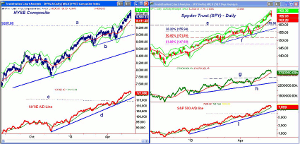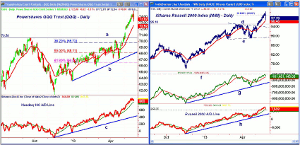Stock markets around the world reacted to the mixed message from the Federal Reserve by selling, with over a 7% drop in Japan’s Nikkei 225. MoneyShow’s Tom Aspray shares his interpretation of Wednesday’s action and three reasons why investors should avoid panic selling.
Wednesday was one of the widest ranging days since the middle of April with a 277 point range in the Dow Industrials and 41 points in the S&P 500. The overnight selling in Asia was exacerbated by a drop in preliminary readings on Chinese manufacturing.
The European markets are also down sharply with the German DAX Index down 2.6% in early trading and the US futures are sharply lower ahead of the latest data on jobless claims that will be released ahead of the US market’s opening.

Several of the major averages formed what is known as key reversals in yesterday’s trading. This chart shows the NYSE Composite (NYA), which opened Wednesday at 9605, above the prior day’s close at 9598. NYA made a significant new high early in the day at 9695, then closed at 9508, which was well below Tuesday’s low at 9556.
The weakness in the asset management stocks after Tuesday’s close looks to have been an advance warning of Wednesday’s drop. Does this mean investors should be selling their stocks?
Chart Analysis: The NYSE Composite tested its daily starc+ band Wednesday before reversing to the downside as noted above.
- The 20-day EMA is at 9411 and is likely to be exceeded early Thursday.
- There is more important support at 9265, which corresponds to the April highs, line a.
- This is 2.5% below Wednesday’s close, and it is the likely first downside target.
- The 38.2% retracement support from the November 2011 low is at 8984, which corresponds to the support at line b.
- The NYSE Advance/Decline line confirmed the recent highs before it turned lower.
- The rising 21 WMA is now being tested with further support at the uptrend, line d.
- There is more important support for the A/D line at line c.
The Spyder Trust (SPY) also formed a key reversal on Wednesday and volume was double the daily average.
- The daily starc- band and the 20-day EMA are now at $163.28.
- The April highs at $159.80 (line e) represent more important support. It is 3.6% below Wednesday’s close.
- The uptrend (line f) and the 38.2% Fibonacci support is now in the $155.94 area.
- The major support is at $153.55, which was the April low.
- The daily OBV confirmed the recent highs and is now testing its WMA.
- There is next support for the OBV at line g.
- The S&P 500 A/D line also confirmed the recent highs and is still holding above its WMA.
- The uptrend in the A/D line (line i) and more important support are considerably below current levels.
NEXT PAGE: What Should You Do Now?
|pagebreak|
The Powershares QQQ Trust (QQQ) also formed a key reversal on Wednesday and closed below Monday’s low at $73.89, so an LCD was also triggered.
- QQQ is still well above the 20-day EMA at $72.52.
- There is more important support at the September high of $70.52, line a, which is just over 4% below current levels.
- The 38.2% Fibonacci support is at $69.72 with the 50% at $68.11 along with the uptrend, line b.
- The Nasdaq 100 A/D line has confirmed the recent highs but turned lower Wednesday.
- There is further support for the A/D line at the April highs with long-term support at line c.
- There is resistance now in the $74-$74.95 area.
The iShares Russell 2000 Index (IWM) had a new all-time high at $100.38 before closing at $97.78.
- The daily chart completed its flag formation, lines d and e, in early May.
- The 161.8% retracement target at $99.07 was exceeded on Monday.
- There is next important support in the $95.10 area and the 38.2% retracement support (not shown) from the November lows is at $91.06.
- The daily OBV tested the recent highs, line f, but did not confirm the new price highs.
- There is key OBV support now at the uptrend, line g.
- The Russell 2000 A/D line did make new highs this week and is still above its WMA.
- The A/D line now has more important support at line h.
What it Means: The confirmation of the new price highs by the weekly and daily NYSE A/D are two solid reasons why you should avoid panic selling. They indicate that after correcting further there should be another rally phase before a significant top could be completed.
The confirmation of the new highs by both the weekly and daily OBV on the Spyder Trust (SPY) and the fact that they have not yet broken important support is another reason not to panic. This indicates that more time is required before significant sell signals could be generated. Both the OBV and A/D lines generally lead prices as was the case last December.
The SPY has a minor target at $163.28 and should hold above the support in the $159.80-$162 area before it rebounds. The iShares Russell 2000 Index (IWM) does look more vulnerable.
I would not chase the inverse ETFs at these levels as they are likely to open much higher, but if a top is confirmed, there will be a better risk/reward entry at a later time. Be sure you have your stops in place and avoid any panic selling.
How to Profit: No new recommendation












